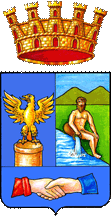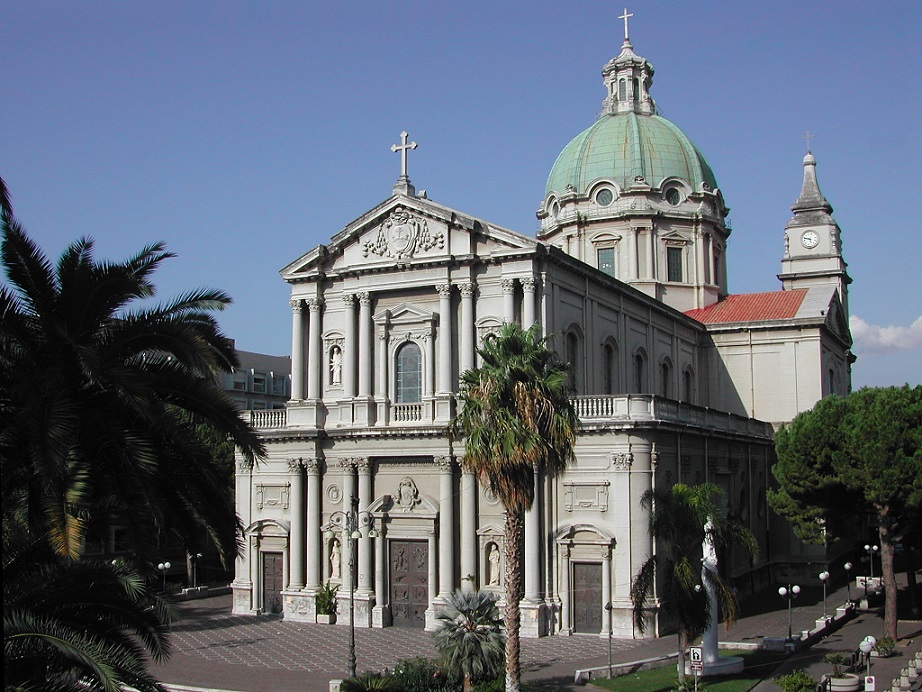

Detto anche “Baccialona Pizzaottu” in siciliano o “Baccialona” o “Baccellona” in dialetto messinese, è il comune più popoloso della Città Metropolitana di Messina. Il nome attinente a quello dell'omonima in Catalogna deve le sue origini probabilmente alla realizzazione di un pozzo per uso irriguo nelle terre coltivate ubicate tra il torrente Idria e il Longano, appartenenti al messinese Nicolò Goto come descritto in latino volgare in un documento datato 1463: “ … Nicolao de Gotho, …, in quo Puzzo de Gotho …”.
Si può fare risalire la sua origine all'epoca del bronzo e del ferro poiché dislocati in vari punti del territorio comunale sono stati rinvenuti reperti del periodo ma anche successivi con diversi insediamenti e Necropoli del X sec. a.C., di epoca greca o ellenistica dell'VIII sec. a.C., sicana greca del V o VI sec. a.C.. Vi è anche l'ipotesi databile 265 a.C. della Battaglia del Longano non perfettamente allocabile.
Intorno al 1090-1094 in seguito alla conquista normanna adopera del Gran Conte Ruggero, che pone fine alla dominazione araba, fu ripristinata la sovranità di matrice cattolica supportata dalla futura Regina Adelasia del Vasto, la quale negli anni 1104-1105 promuove la rifondazione del monastero e abbazia di Santa Maria di Gala nell'omonima località retto dai basiliani dirito greco sui resti di preesistenti costruzioni romane. Nel 1130 il territorio fu inserito nel Vallo di Milazzo le cui proprietà erano del Gran Conte Ruggero.
Dal 1282 al 1556 tutti i re di Sicilia della Casata di Aragona rivestono anche il ruolo di Conti di Barcellona di Catalogna.
Tra il 1282 e il1302 il territorio è sede di battaglie collegate ai Vespri Siciliani. E altre battaglie seguirono tra il 1314 e il 1321.
Dal 1392 il territorio diviso in casali Gala e Nasali viene poi trasformato in feudi e comprende anche Lando, Gurafi, Migliardo e Centineo. Il nucleo più antico della cittadina si identifica in Pozzo di Gotto.
Nicolò Gotho figlio primogenito di Leonardo Gotho barone della Floresta fece costruire il Castello dei Gotho di Santo Stefano Briga e nel 1464 diviene proprietario di diversi apprezzamenti nella Piana di Milazzo. La frazione a occidente del torrente Longano a sua volta dipendeva dalla giurisdizione di Castroreale ed alcuni atti del 1522 riportano la denominazione della contrada o casale di "Barsalona", nome da attribuire verosimilmente alla presenza nei libri battesimali di Pozzo di Gotto del nominativo di "Graziosa Barsalona", per contro è avvalorata la tesi che il nome alla località sia stato attribuito dai dominatori iberici avendo ravvisato la notevole similitudine con la città catalana.
Nel 1571 i Pozzogottesi ottengono dalla Gran Corte Arcivescovile di Messina l'autorizzazione a eleggere il loro Cappellano di stanza a S. Vito senza più dipendere dall'Arcipretura di Milazzo. Il 22 maggio 1639 e sancito con regio decreto del Vicerè e Cardinale Giannettino Doria sotto il regno di Filippo IV di Spagna il centro assume il titolo "'Libera et Realis Civitas Putei de Gotho" e il rappresentante cittadino occupa l'ultimo posto nei «Parlamenti Generali del Regno. Nel 1583 il territorio è compreso nella Comarca di Castroreale ed ha rappresentanza presso il parlamento siciliano
Negli anni tra il 1674 e il 1674 partecipa alla rivolta contro gli spagnoli.
Successivamente tra il 1713 e il 1720 si vede la cosiddetta parentesi savoiarda con Vittorio Amedeo II, durante i quali il territorio è teatro di scontri tra Filippo V di Spagna e la coalizione della Quadruplice Alleanza, culminati poi nella battaglia di Milazzo e di Francavilla.
Tra il 1720 e il 1734 la città passa sotto il dominio asburgico con Carlo VI, e senza rappresentanza parlamentare è istitutita la “Comarca di Pozzo di Gotto”. Nel 1734 il Regno di Sicilia passa a Carlo III di Spagna dei Borboni di Napoli.
In seguito all’alluvione del 1757 del torrente Longano vengono costruiti dei Bastioni e la foce del fiume spostata per non creare intralcio allo scalo marittimo di Calderà.
Nel XVIII secolo vengono riportati toponimi di “Barsalona” e “Barcellonetta”.
Nel 1815 in seguito alla unificazione del Regno di Napoli e del Regno di Sicilia nel “Regno delle due Sicilie”, fu costruito un ponte di legno presso la chiesa di S. Cosimo che collegava i due iniziali casali, l'autonomia del casale di Barcellona è deliberata da Parlamento Siciliano e riconosciuta dal Re il 15 maggio. L'unione amministrativa decretata il 5 gennaio 1835 ed entrata in vigore il 1 giugno 1836, stabilisce la fusione delle due contrade e che il nuovo comune porti il nome di Barcellona Pozzo di Gotto.
Nel 1848 in seguito ai moti rivoluzionari ,gli austriaci sono costretti a lasciare la città. Sempre nel 1848 con la Rivoluzione Siciliana i Borboni attuano un'azione oppressiva recrudescente nei confronti di Barcellona.
Il 20 luglio 1860 Barcellona, grazie ai successi delle imprese garibaldine diviene un centro importante per l'insurrezione e dopo la Battaglia di Corriolo partecipa attivamente alla Battaglia di Milazzo per la conquista delCastello e la cacciata dei Borboni, per tali azioni Garibaldi la insignì del titolo di “Patriottica”.
Nel 1866 conl'emanazione delle leggi eversive vi fu la confisca dei beni agli ordini religiosi.
Nel 1890 viene inaugurata la linea ferrata per la tratta Barcellona-Milazzo.
Nel 1908 il disastroso terremoto di Messina si avverte anche in città.
Il 15 agosto 1943 il bombardamento angloamericano causa 74 vittime e il 23 settembre il 525º Squadrone dell'86º Gruppo Cacciabombardieri si trasferisce con gli A-36 da Barcellona al campo di aviazione di Sele.
Il 31 maggio 1967 un incendia il Teatro Mandanici e si creano i Giardini Oasi.
Il comune è suddiviso in diverse frazioni: La Gala, S.Paolo, Cannistrà, Acquaficara, Centineo, Portosalvo, Femminamorta, Migliardo, Acquacalda, Oreto, S. Venera, Calderà, S. Antonio Abate e C.da Cantoni.
Nel suo territorio ci sono molti importanti monumenti.
(English)
Also called "Baccialona Pizzaottu" in Sicilian or "Baccialona" or "Baccellona" in Messina dialect is the most populous municipality in the Città Metropolitana di Messina.
The name related to that of the same name in Catalonia probably owes its origins to the construction of a well for irrigation use in the cultivated lands located between the stream Idria and Longano, belonging to the Messina Nicolò Goto as described in vulgar Latin in a document dated 1463: " ... Nicolao de Gotho, ..., in quo Puzzo de Gotho ...". Its origin can be traced back to the age of bronze and iron as dislocated in various points of the municipal territory have been found finds of the period but also later with several settlements and necropolis of the tenth century. a.C., of Greek or Hellenistic age of the VIII century B.C., Greek Sican of the V or VI century B.C.. There is also the datable hypothesis 265 B.C. of the Battle of Longano not perfectly allocable. Around 1090-1094 following the Norman conquest adopted by the Great Count Roger, which ends the Arab domination, was restored the sovereignty of the Catholic matrix supported by the future Queen Adelasia del Vasto, which in the years 1104-1105 promotes the re-foundation of the monastery and abbey of Santa Maria di Gala in the homonymous locality held by the Basilian greek right on the remains of existing Roman buildings. In 1130 the territory was inserted in the Wall of Milazzo whose properties were of the Great Count Roger.
From 1282 to 1556 all the Kings of Sicily of the House of Aragon also played the role of counts of Barcelona of Catalonia.
Between 1282 and 1302 the territory is home to battles connected to the Sicilian Vespers. And other battles followed between 1314 and 1321.
From 1392 the territory divided into the casali Gala and Nasali was then transformed into feuds and also includes Lando, Gurafi, Migliardo and Centineo. The oldest nucleus of the town is identified in Pozzo di Gotto.
Nicholas Gotho eldest son of Leonardo Gotho Baron of Floresta built the castle of the Gotho of Santo Stefano Briga and in 1464 became the owner of several lands in The Plain of Milazzo. The hamlet to the west of the Longano stream in turn depended on the jurisdiction of Castroreale and some acts of 1522 report the name of the district or casale of "Barsalona", a name likely to be attributed to the presence in the baptismal books of Pozzo di Gotto of the name of "Graziosa Barsalona", on the other hand, the thesis is confirmed that the name to the place was attributed by the Iberian Dominators having recognized the remarkable similarity with the Catalan city.
In 1571 the Pozzogottesi obtained from the Grand Archiepiscopal Court of Messina the authorization to elect their chaplain stationed in S. Vito without any longer depending on the Archpreture of Milazzo. On 22 May 1639 and sanctioned by royal decree of the Viceroy and Cardinal Giannettino Doria under the reign of Philip IV of Spain the center assumes the title "'Libera et Realis Civitas Putei De Gotho" and the city representative occupies the last place in the "General parliaments of the Kingdom. In 1583 the territory is included in the Comarca of Castroreale and has representation in the Sicilian Parliament
In the years between 1674 and 1674 he participated in the revolt against the Spanish.
Later between 1713 and 1720 the so-called Savoyard parenthesis with Victor Amadeus II, during which the territory is the theater of clashes between Philip V of Spain and the coalition of the Quadruple Alliance, culminating in the Battle of Milazzo and Francavilla.
Between 1720 and 1734 the city passed under Habsburg rule with Charles VI, and without parliamentary representation the "Comarca di Pozzo di Gotto" was established. In 1734 the Kingdom of Sicily passed to Charles III of Spain of the Bourbons of Naples.
Following the 1757 flood of the Longano stream, Bastions were built and the mouth of the river moved to avoid creating an obstacle to the Calrà sea port.
In the 18th century, the place names of "Barsalona" and "Barcellonetta" were given.
In 1815 later to unification of the Kingdom of Naples and the Kingdom of Sicily in the "Kingdom of the two Sicilies", a wooden bridge was built at the church of S. Cosimo connecting the two original farmhouses, the autonomy of the farmhouse of Barcelona is deliberated by Sicilian Parliament and recognized by the King on May 15. The administrative union decreed on 5 January 1835 and entered into force on 1 June 1836, establishes the merger of the two districts and that the new municipality bears the name of Barcelona Pozzo di Gotto.
In 1848, after the revolution, the Austrians were forced to leave the city. Also in 1848 with the Sicilian Revolution the Bourbons carried out a resurgent oppressive action against Barcelona.
On 20 July 1860 Barcelona, thanks to the successes of the Garibaldine companies, became an important center for the insurrection and after the Battle of Corriolo participated actively in the Battle of Milazzo for the conquest of the Castle and the expulsion of the Bourbons, for such actions Garibaldi awarded her the title of "Patriotic".
In 1866 with the enactment of subversive laws there was the confiscation of property from religious orders.
In 1890 the railway line for the Barcelona-Milazzo route was opened.
In 1908, the disastrous earthquake in Messina was felt in the city.
On 15 August 1943, the Anglo-American bombing killed 74 people, and on 23 September, the 525th Squadron of the 86th Fighter-bomber Group moved with A-36s from Barcelona to the Sele airfield.
On May 31, 1967, a fire burned the Mandanici Theater and the Oasis Gardens were created.
The municipality is divided into several parts: La Gala, S.Paolo, Cannistrà, Acquaficara, Centineo, Portosalvo, Femminamorta, Migliardo, Acquacalda, Oreto, S. Venera, Calrà, S. Antonio Abate and C.da Cantoni.
In his territory there are several important monuments.